Wireless Networking Technologies
VerifiedAdded on 2020/03/02
|10
|1563
|36
AI Summary
This assignment delves into the realm of advanced wireless networking technologies. It examines various techniques such as FDMA, TDMA, CDMA, and explores their applications and advantages. The focus extends to modern advancements like WiGig and their potential to revolutionize business communication. The document also analyzes the pros and cons of different antenna types used in wireless networks, including horn antennas and Yagi antennas. Finally, it highlights the need for selecting the most effective technology based on specific requirements.
Contribute Materials
Your contribution can guide someone’s learning journey. Share your
documents today.
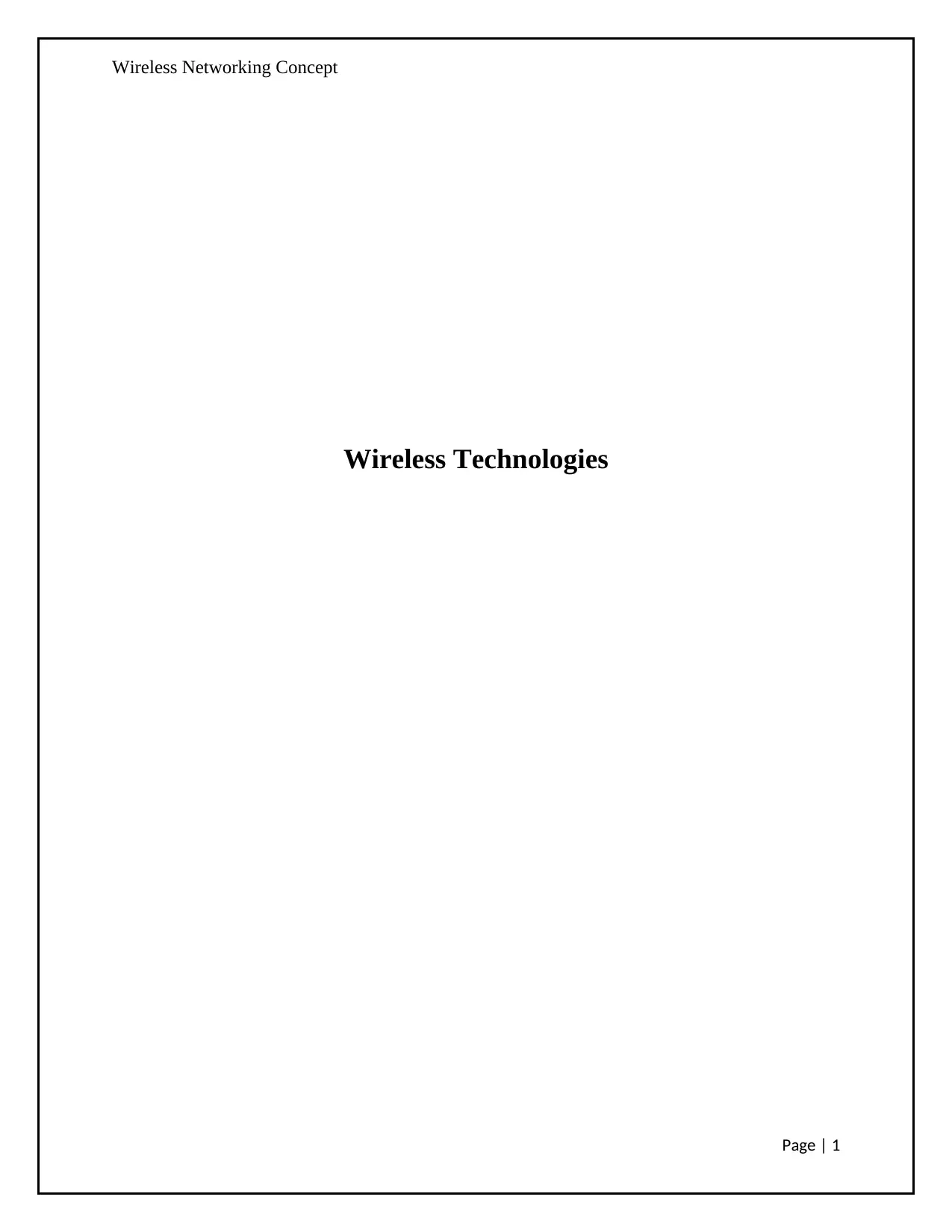
Wireless Networking Concept
Wireless Technologies
Page | 1
Wireless Technologies
Page | 1
Secure Best Marks with AI Grader
Need help grading? Try our AI Grader for instant feedback on your assignments.
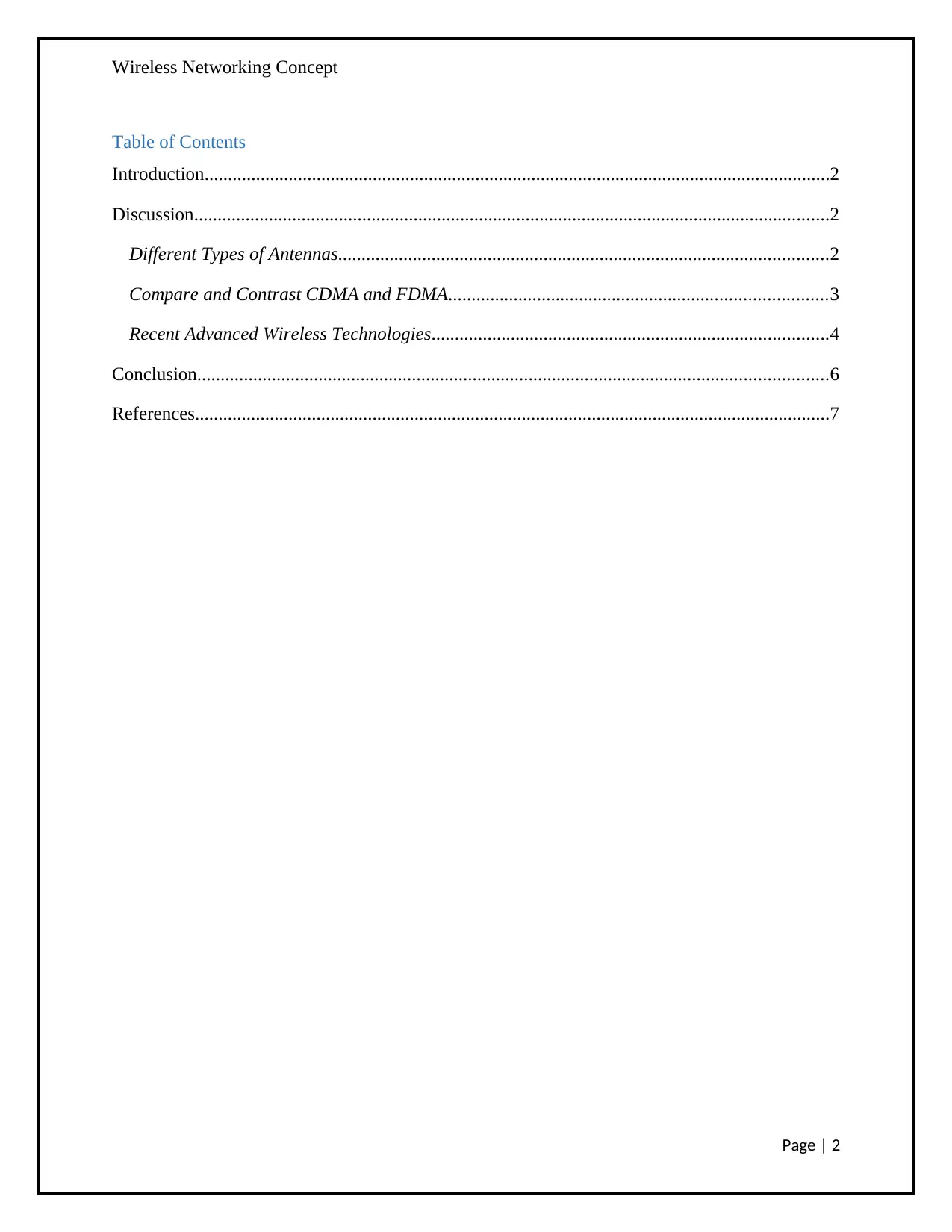
Wireless Networking Concept
Table of Contents
Introduction......................................................................................................................................2
Discussion........................................................................................................................................2
Different Types of Antennas.........................................................................................................2
Compare and Contrast CDMA and FDMA.................................................................................3
Recent Advanced Wireless Technologies.....................................................................................4
Conclusion.......................................................................................................................................6
References........................................................................................................................................7
Page | 2
Table of Contents
Introduction......................................................................................................................................2
Discussion........................................................................................................................................2
Different Types of Antennas.........................................................................................................2
Compare and Contrast CDMA and FDMA.................................................................................3
Recent Advanced Wireless Technologies.....................................................................................4
Conclusion.......................................................................................................................................6
References........................................................................................................................................7
Page | 2
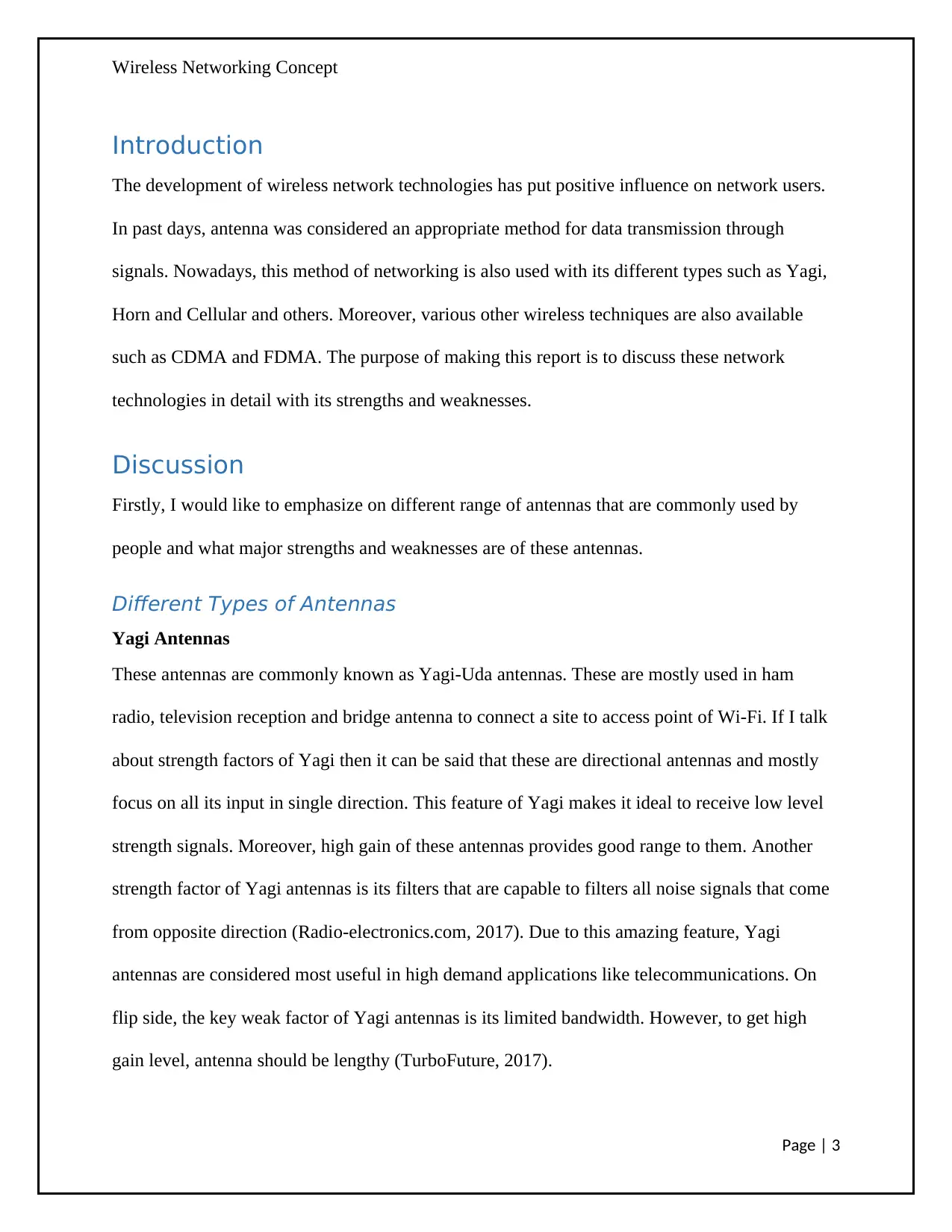
Wireless Networking Concept
Introduction
The development of wireless network technologies has put positive influence on network users.
In past days, antenna was considered an appropriate method for data transmission through
signals. Nowadays, this method of networking is also used with its different types such as Yagi,
Horn and Cellular and others. Moreover, various other wireless techniques are also available
such as CDMA and FDMA. The purpose of making this report is to discuss these network
technologies in detail with its strengths and weaknesses.
Discussion
Firstly, I would like to emphasize on different range of antennas that are commonly used by
people and what major strengths and weaknesses are of these antennas.
Different Types of Antennas
Yagi Antennas
These antennas are commonly known as Yagi-Uda antennas. These are mostly used in ham
radio, television reception and bridge antenna to connect a site to access point of Wi-Fi. If I talk
about strength factors of Yagi then it can be said that these are directional antennas and mostly
focus on all its input in single direction. This feature of Yagi makes it ideal to receive low level
strength signals. Moreover, high gain of these antennas provides good range to them. Another
strength factor of Yagi antennas is its filters that are capable to filters all noise signals that come
from opposite direction (Radio-electronics.com, 2017). Due to this amazing feature, Yagi
antennas are considered most useful in high demand applications like telecommunications. On
flip side, the key weak factor of Yagi antennas is its limited bandwidth. However, to get high
gain level, antenna should be lengthy (TurboFuture, 2017).
Page | 3
Introduction
The development of wireless network technologies has put positive influence on network users.
In past days, antenna was considered an appropriate method for data transmission through
signals. Nowadays, this method of networking is also used with its different types such as Yagi,
Horn and Cellular and others. Moreover, various other wireless techniques are also available
such as CDMA and FDMA. The purpose of making this report is to discuss these network
technologies in detail with its strengths and weaknesses.
Discussion
Firstly, I would like to emphasize on different range of antennas that are commonly used by
people and what major strengths and weaknesses are of these antennas.
Different Types of Antennas
Yagi Antennas
These antennas are commonly known as Yagi-Uda antennas. These are mostly used in ham
radio, television reception and bridge antenna to connect a site to access point of Wi-Fi. If I talk
about strength factors of Yagi then it can be said that these are directional antennas and mostly
focus on all its input in single direction. This feature of Yagi makes it ideal to receive low level
strength signals. Moreover, high gain of these antennas provides good range to them. Another
strength factor of Yagi antennas is its filters that are capable to filters all noise signals that come
from opposite direction (Radio-electronics.com, 2017). Due to this amazing feature, Yagi
antennas are considered most useful in high demand applications like telecommunications. On
flip side, the key weak factor of Yagi antennas is its limited bandwidth. However, to get high
gain level, antenna should be lengthy (TurboFuture, 2017).
Page | 3

Wireless Networking Concept
Page | 4
Page | 4
Secure Best Marks with AI Grader
Need help grading? Try our AI Grader for instant feedback on your assignments.
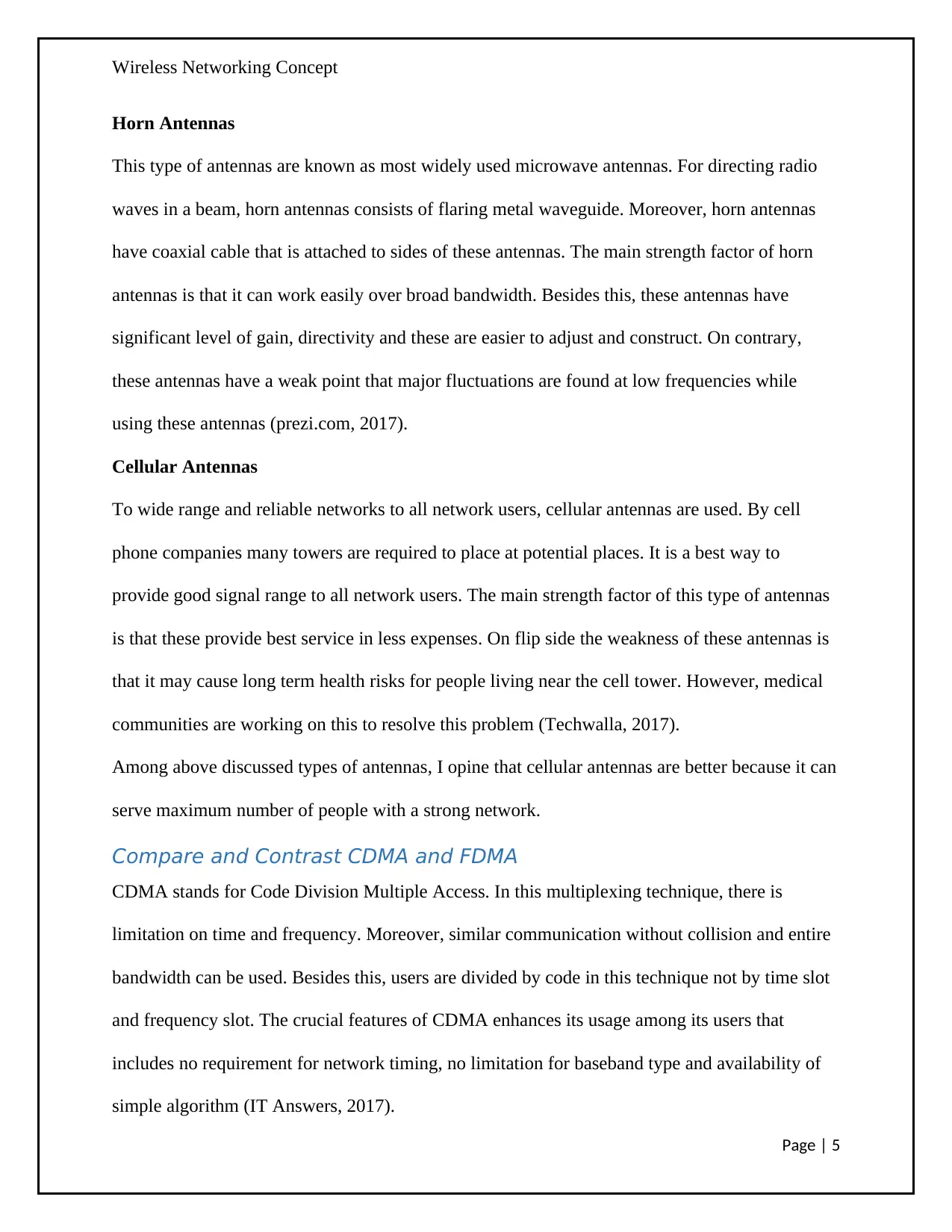
Wireless Networking Concept
Horn Antennas
This type of antennas are known as most widely used microwave antennas. For directing radio
waves in a beam, horn antennas consists of flaring metal waveguide. Moreover, horn antennas
have coaxial cable that is attached to sides of these antennas. The main strength factor of horn
antennas is that it can work easily over broad bandwidth. Besides this, these antennas have
significant level of gain, directivity and these are easier to adjust and construct. On contrary,
these antennas have a weak point that major fluctuations are found at low frequencies while
using these antennas (prezi.com, 2017).
Cellular Antennas
To wide range and reliable networks to all network users, cellular antennas are used. By cell
phone companies many towers are required to place at potential places. It is a best way to
provide good signal range to all network users. The main strength factor of this type of antennas
is that these provide best service in less expenses. On flip side the weakness of these antennas is
that it may cause long term health risks for people living near the cell tower. However, medical
communities are working on this to resolve this problem (Techwalla, 2017).
Among above discussed types of antennas, I opine that cellular antennas are better because it can
serve maximum number of people with a strong network.
Compare and Contrast CDMA and FDMA
CDMA stands for Code Division Multiple Access. In this multiplexing technique, there is
limitation on time and frequency. Moreover, similar communication without collision and entire
bandwidth can be used. Besides this, users are divided by code in this technique not by time slot
and frequency slot. The crucial features of CDMA enhances its usage among its users that
includes no requirement for network timing, no limitation for baseband type and availability of
simple algorithm (IT Answers, 2017).
Page | 5
Horn Antennas
This type of antennas are known as most widely used microwave antennas. For directing radio
waves in a beam, horn antennas consists of flaring metal waveguide. Moreover, horn antennas
have coaxial cable that is attached to sides of these antennas. The main strength factor of horn
antennas is that it can work easily over broad bandwidth. Besides this, these antennas have
significant level of gain, directivity and these are easier to adjust and construct. On contrary,
these antennas have a weak point that major fluctuations are found at low frequencies while
using these antennas (prezi.com, 2017).
Cellular Antennas
To wide range and reliable networks to all network users, cellular antennas are used. By cell
phone companies many towers are required to place at potential places. It is a best way to
provide good signal range to all network users. The main strength factor of this type of antennas
is that these provide best service in less expenses. On flip side the weakness of these antennas is
that it may cause long term health risks for people living near the cell tower. However, medical
communities are working on this to resolve this problem (Techwalla, 2017).
Among above discussed types of antennas, I opine that cellular antennas are better because it can
serve maximum number of people with a strong network.
Compare and Contrast CDMA and FDMA
CDMA stands for Code Division Multiple Access. In this multiplexing technique, there is
limitation on time and frequency. Moreover, similar communication without collision and entire
bandwidth can be used. Besides this, users are divided by code in this technique not by time slot
and frequency slot. The crucial features of CDMA enhances its usage among its users that
includes no requirement for network timing, no limitation for baseband type and availability of
simple algorithm (IT Answers, 2017).
Page | 5
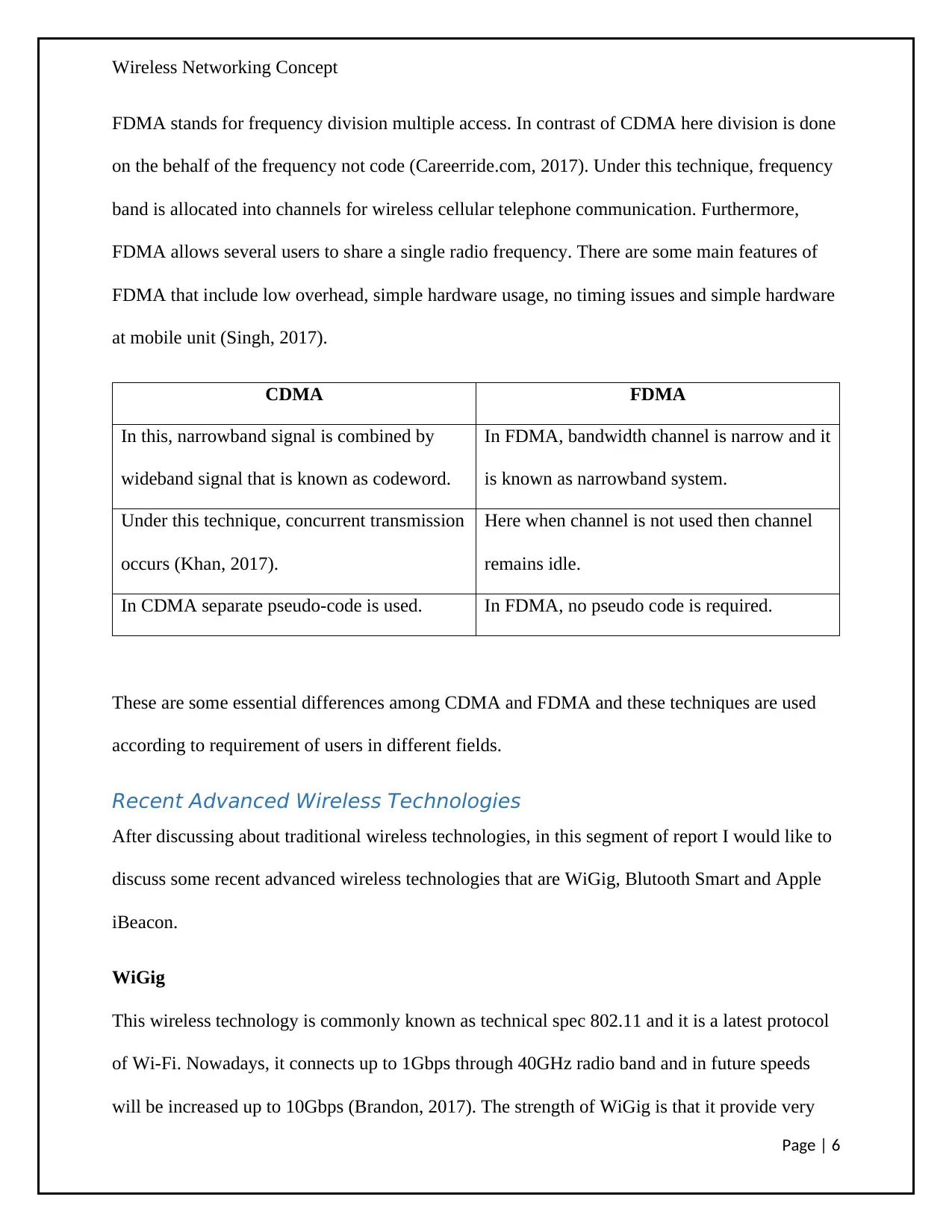
Wireless Networking Concept
FDMA stands for frequency division multiple access. In contrast of CDMA here division is done
on the behalf of the frequency not code (Careerride.com, 2017). Under this technique, frequency
band is allocated into channels for wireless cellular telephone communication. Furthermore,
FDMA allows several users to share a single radio frequency. There are some main features of
FDMA that include low overhead, simple hardware usage, no timing issues and simple hardware
at mobile unit (Singh, 2017).
CDMA FDMA
In this, narrowband signal is combined by
wideband signal that is known as codeword.
In FDMA, bandwidth channel is narrow and it
is known as narrowband system.
Under this technique, concurrent transmission
occurs (Khan, 2017).
Here when channel is not used then channel
remains idle.
In CDMA separate pseudo-code is used. In FDMA, no pseudo code is required.
These are some essential differences among CDMA and FDMA and these techniques are used
according to requirement of users in different fields.
Recent Advanced Wireless Technologies
After discussing about traditional wireless technologies, in this segment of report I would like to
discuss some recent advanced wireless technologies that are WiGig, Blutooth Smart and Apple
iBeacon.
WiGig
This wireless technology is commonly known as technical spec 802.11 and it is a latest protocol
of Wi-Fi. Nowadays, it connects up to 1Gbps through 40GHz radio band and in future speeds
will be increased up to 10Gbps (Brandon, 2017). The strength of WiGig is that it provide very
Page | 6
FDMA stands for frequency division multiple access. In contrast of CDMA here division is done
on the behalf of the frequency not code (Careerride.com, 2017). Under this technique, frequency
band is allocated into channels for wireless cellular telephone communication. Furthermore,
FDMA allows several users to share a single radio frequency. There are some main features of
FDMA that include low overhead, simple hardware usage, no timing issues and simple hardware
at mobile unit (Singh, 2017).
CDMA FDMA
In this, narrowband signal is combined by
wideband signal that is known as codeword.
In FDMA, bandwidth channel is narrow and it
is known as narrowband system.
Under this technique, concurrent transmission
occurs (Khan, 2017).
Here when channel is not used then channel
remains idle.
In CDMA separate pseudo-code is used. In FDMA, no pseudo code is required.
These are some essential differences among CDMA and FDMA and these techniques are used
according to requirement of users in different fields.
Recent Advanced Wireless Technologies
After discussing about traditional wireless technologies, in this segment of report I would like to
discuss some recent advanced wireless technologies that are WiGig, Blutooth Smart and Apple
iBeacon.
WiGig
This wireless technology is commonly known as technical spec 802.11 and it is a latest protocol
of Wi-Fi. Nowadays, it connects up to 1Gbps through 40GHz radio band and in future speeds
will be increased up to 10Gbps (Brandon, 2017). The strength of WiGig is that it provide very
Page | 6
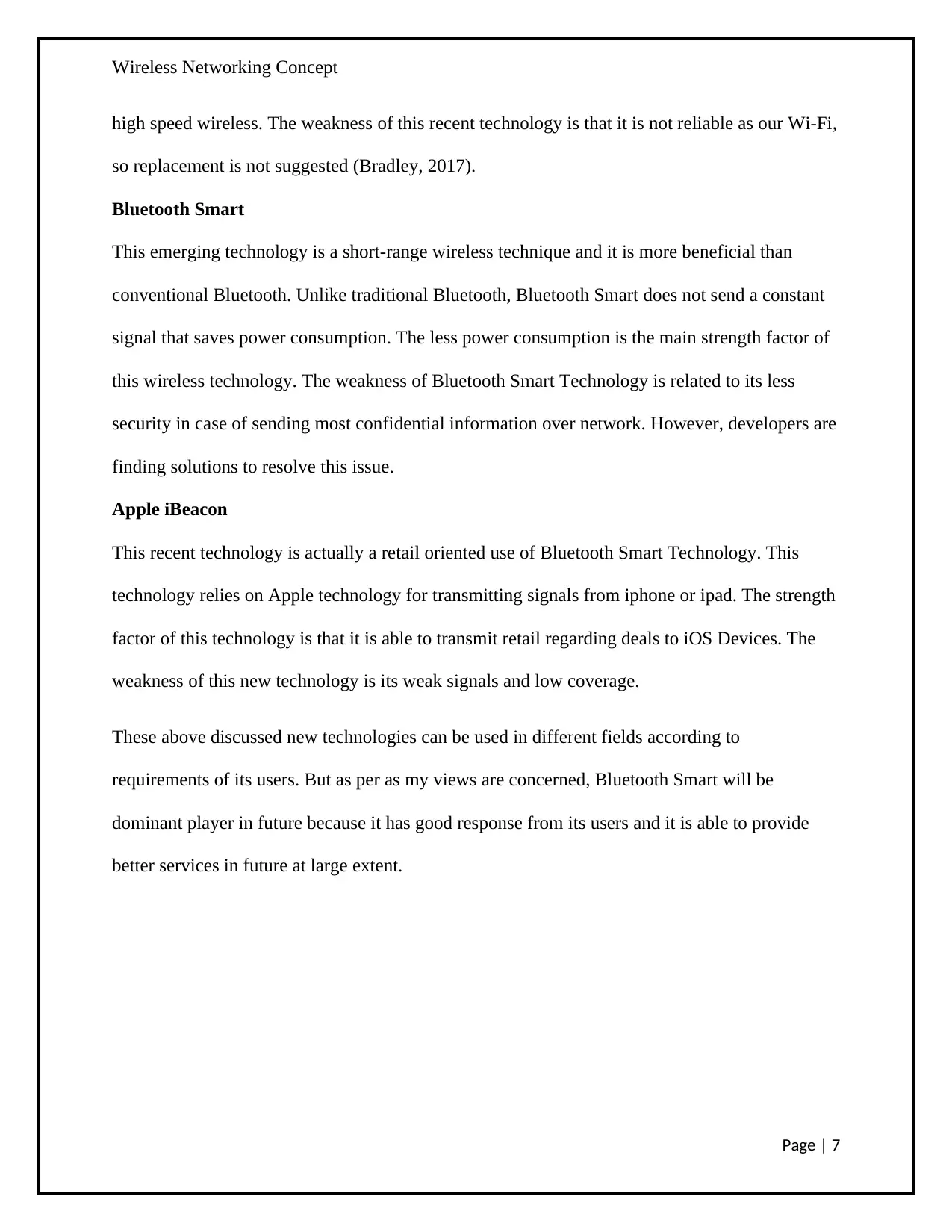
Wireless Networking Concept
high speed wireless. The weakness of this recent technology is that it is not reliable as our Wi-Fi,
so replacement is not suggested (Bradley, 2017).
Bluetooth Smart
This emerging technology is a short-range wireless technique and it is more beneficial than
conventional Bluetooth. Unlike traditional Bluetooth, Bluetooth Smart does not send a constant
signal that saves power consumption. The less power consumption is the main strength factor of
this wireless technology. The weakness of Bluetooth Smart Technology is related to its less
security in case of sending most confidential information over network. However, developers are
finding solutions to resolve this issue.
Apple iBeacon
This recent technology is actually a retail oriented use of Bluetooth Smart Technology. This
technology relies on Apple technology for transmitting signals from iphone or ipad. The strength
factor of this technology is that it is able to transmit retail regarding deals to iOS Devices. The
weakness of this new technology is its weak signals and low coverage.
These above discussed new technologies can be used in different fields according to
requirements of its users. But as per as my views are concerned, Bluetooth Smart will be
dominant player in future because it has good response from its users and it is able to provide
better services in future at large extent.
Page | 7
high speed wireless. The weakness of this recent technology is that it is not reliable as our Wi-Fi,
so replacement is not suggested (Bradley, 2017).
Bluetooth Smart
This emerging technology is a short-range wireless technique and it is more beneficial than
conventional Bluetooth. Unlike traditional Bluetooth, Bluetooth Smart does not send a constant
signal that saves power consumption. The less power consumption is the main strength factor of
this wireless technology. The weakness of Bluetooth Smart Technology is related to its less
security in case of sending most confidential information over network. However, developers are
finding solutions to resolve this issue.
Apple iBeacon
This recent technology is actually a retail oriented use of Bluetooth Smart Technology. This
technology relies on Apple technology for transmitting signals from iphone or ipad. The strength
factor of this technology is that it is able to transmit retail regarding deals to iOS Devices. The
weakness of this new technology is its weak signals and low coverage.
These above discussed new technologies can be used in different fields according to
requirements of its users. But as per as my views are concerned, Bluetooth Smart will be
dominant player in future because it has good response from its users and it is able to provide
better services in future at large extent.
Page | 7
Paraphrase This Document
Need a fresh take? Get an instant paraphrase of this document with our AI Paraphraser

Wireless Networking Concept
Conclusion
To conclude, it can be said that over the time various advanced technologies are coming in field
of wireless networking and with the help of these techniques network users can get various
benefits as we have discussed above but they need to select effective technology among them.
Page | 8
Conclusion
To conclude, it can be said that over the time various advanced technologies are coming in field
of wireless networking and with the help of these techniques network users can get various
benefits as we have discussed above but they need to select effective technology among them.
Page | 8
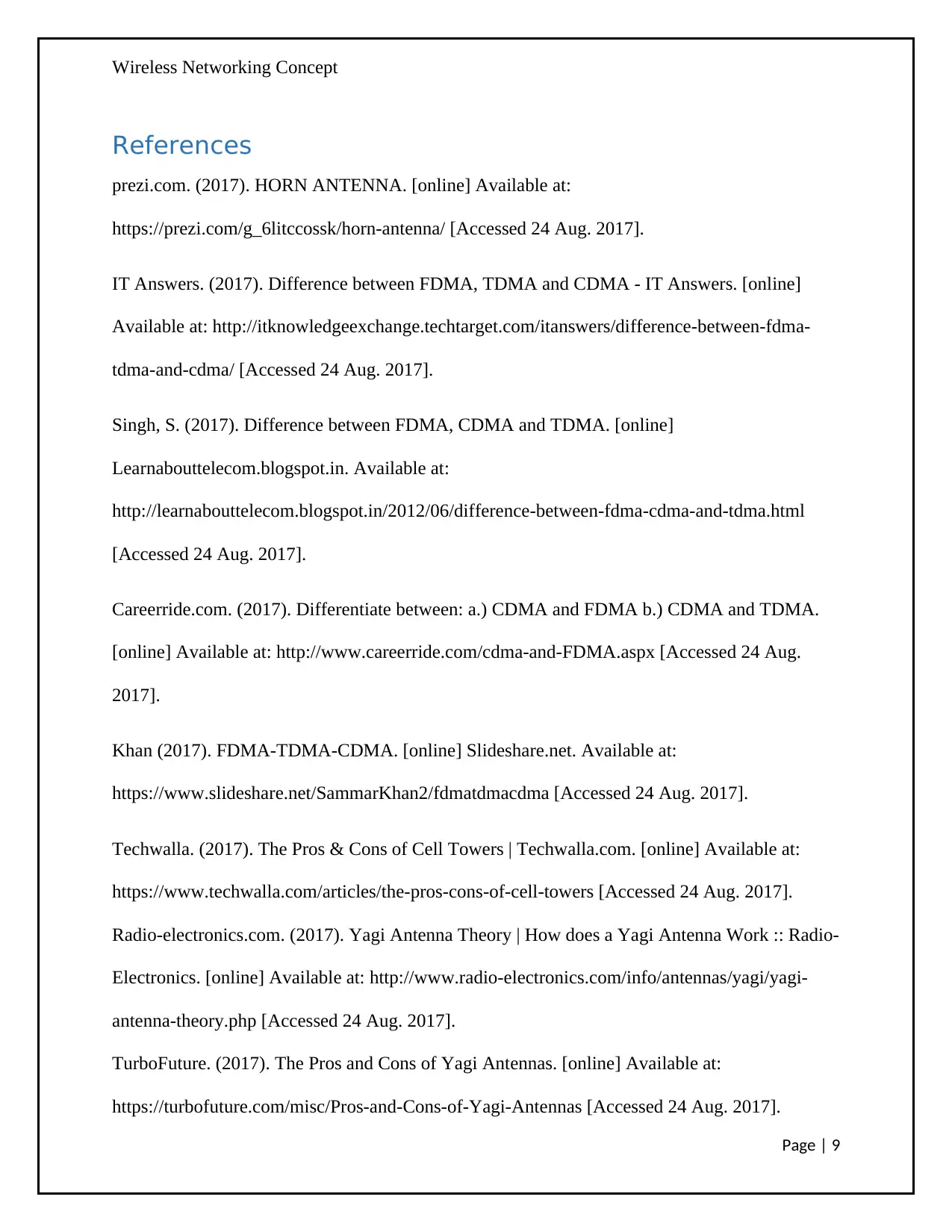
Wireless Networking Concept
References
prezi.com. (2017). HORN ANTENNA. [online] Available at:
https://prezi.com/g_6litccossk/horn-antenna/ [Accessed 24 Aug. 2017].
IT Answers. (2017). Difference between FDMA, TDMA and CDMA - IT Answers. [online]
Available at: http://itknowledgeexchange.techtarget.com/itanswers/difference-between-fdma-
tdma-and-cdma/ [Accessed 24 Aug. 2017].
Singh, S. (2017). Difference between FDMA, CDMA and TDMA. [online]
Learnabouttelecom.blogspot.in. Available at:
http://learnabouttelecom.blogspot.in/2012/06/difference-between-fdma-cdma-and-tdma.html
[Accessed 24 Aug. 2017].
Careerride.com. (2017). Differentiate between: a.) CDMA and FDMA b.) CDMA and TDMA.
[online] Available at: http://www.careerride.com/cdma-and-FDMA.aspx [Accessed 24 Aug.
2017].
Khan (2017). FDMA-TDMA-CDMA. [online] Slideshare.net. Available at:
https://www.slideshare.net/SammarKhan2/fdmatdmacdma [Accessed 24 Aug. 2017].
Techwalla. (2017). The Pros & Cons of Cell Towers | Techwalla.com. [online] Available at:
https://www.techwalla.com/articles/the-pros-cons-of-cell-towers [Accessed 24 Aug. 2017].
Radio-electronics.com. (2017). Yagi Antenna Theory | How does a Yagi Antenna Work :: Radio-
Electronics. [online] Available at: http://www.radio-electronics.com/info/antennas/yagi/yagi-
antenna-theory.php [Accessed 24 Aug. 2017].
TurboFuture. (2017). The Pros and Cons of Yagi Antennas. [online] Available at:
https://turbofuture.com/misc/Pros-and-Cons-of-Yagi-Antennas [Accessed 24 Aug. 2017].
Page | 9
References
prezi.com. (2017). HORN ANTENNA. [online] Available at:
https://prezi.com/g_6litccossk/horn-antenna/ [Accessed 24 Aug. 2017].
IT Answers. (2017). Difference between FDMA, TDMA and CDMA - IT Answers. [online]
Available at: http://itknowledgeexchange.techtarget.com/itanswers/difference-between-fdma-
tdma-and-cdma/ [Accessed 24 Aug. 2017].
Singh, S. (2017). Difference between FDMA, CDMA and TDMA. [online]
Learnabouttelecom.blogspot.in. Available at:
http://learnabouttelecom.blogspot.in/2012/06/difference-between-fdma-cdma-and-tdma.html
[Accessed 24 Aug. 2017].
Careerride.com. (2017). Differentiate between: a.) CDMA and FDMA b.) CDMA and TDMA.
[online] Available at: http://www.careerride.com/cdma-and-FDMA.aspx [Accessed 24 Aug.
2017].
Khan (2017). FDMA-TDMA-CDMA. [online] Slideshare.net. Available at:
https://www.slideshare.net/SammarKhan2/fdmatdmacdma [Accessed 24 Aug. 2017].
Techwalla. (2017). The Pros & Cons of Cell Towers | Techwalla.com. [online] Available at:
https://www.techwalla.com/articles/the-pros-cons-of-cell-towers [Accessed 24 Aug. 2017].
Radio-electronics.com. (2017). Yagi Antenna Theory | How does a Yagi Antenna Work :: Radio-
Electronics. [online] Available at: http://www.radio-electronics.com/info/antennas/yagi/yagi-
antenna-theory.php [Accessed 24 Aug. 2017].
TurboFuture. (2017). The Pros and Cons of Yagi Antennas. [online] Available at:
https://turbofuture.com/misc/Pros-and-Cons-of-Yagi-Antennas [Accessed 24 Aug. 2017].
Page | 9
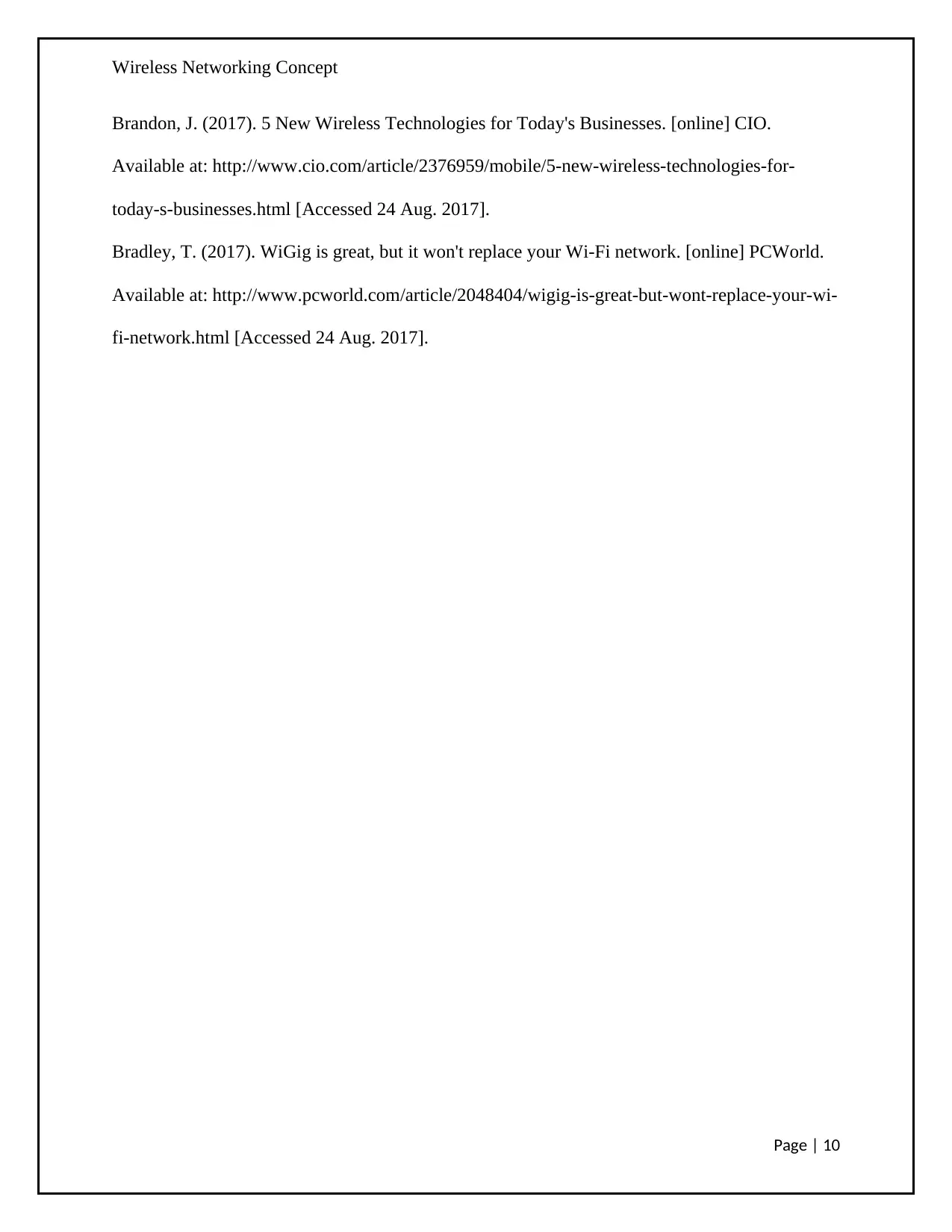
Wireless Networking Concept
Brandon, J. (2017). 5 New Wireless Technologies for Today's Businesses. [online] CIO.
Available at: http://www.cio.com/article/2376959/mobile/5-new-wireless-technologies-for-
today-s-businesses.html [Accessed 24 Aug. 2017].
Bradley, T. (2017). WiGig is great, but it won't replace your Wi-Fi network. [online] PCWorld.
Available at: http://www.pcworld.com/article/2048404/wigig-is-great-but-wont-replace-your-wi-
fi-network.html [Accessed 24 Aug. 2017].
Page | 10
Brandon, J. (2017). 5 New Wireless Technologies for Today's Businesses. [online] CIO.
Available at: http://www.cio.com/article/2376959/mobile/5-new-wireless-technologies-for-
today-s-businesses.html [Accessed 24 Aug. 2017].
Bradley, T. (2017). WiGig is great, but it won't replace your Wi-Fi network. [online] PCWorld.
Available at: http://www.pcworld.com/article/2048404/wigig-is-great-but-wont-replace-your-wi-
fi-network.html [Accessed 24 Aug. 2017].
Page | 10
1 out of 10
Related Documents
Your All-in-One AI-Powered Toolkit for Academic Success.
+13062052269
info@desklib.com
Available 24*7 on WhatsApp / Email
![[object Object]](/_next/static/media/star-bottom.7253800d.svg)
Unlock your academic potential
© 2024 | Zucol Services PVT LTD | All rights reserved.





